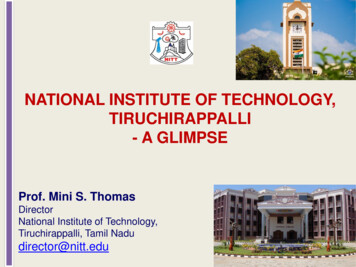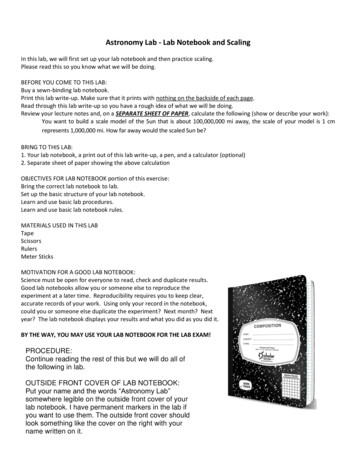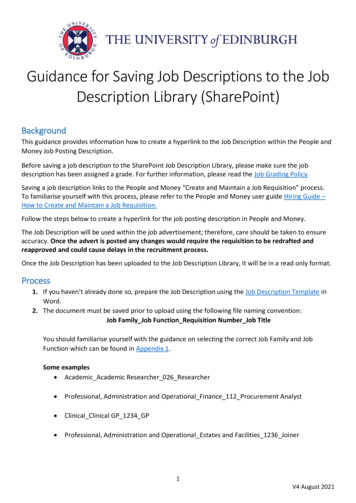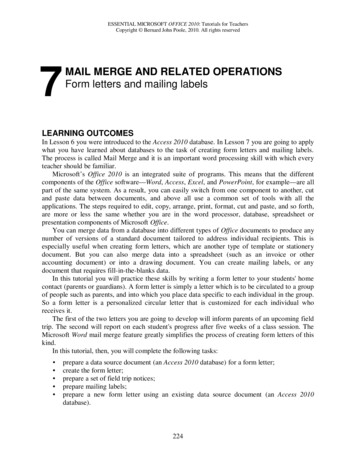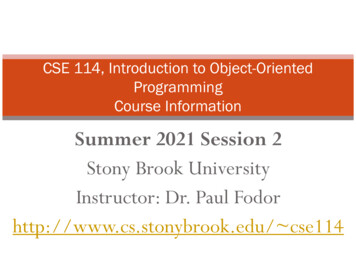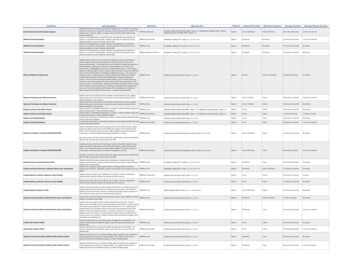
Transcription
Lab NameActive Directory Security Checkup CapstoneAdditional Scanning OptionsAdditional Scanning OptionsAdditional Scanning OptionsAdvanced Malware Analysis LabsAdvanced Techniques for Malware RecoveryAdvanced Techniques for Malware RecoveryAnalysis and Recommendation ReportAnalysis and Recommendation ReportAnalyze and Classify MalwareAnalyze and Classify MalwareAnalyze and Update a Company BCP/BIA/DRP/CIRPLab DescriptionActive Directory's are an important part of many organizations' IT structure. Thus, ActiveDirectory security is just as important and there are several best practices to follow. Thiscapstone tests a student's ability to manage an Active Directory while implementingthose best practices.Students will leverage Nmap, a network discovery and mapping tool, to identify thesystems on a network of responsibility. Students will utilize non-traditional scans toattempt avoiding an Intrusion Detection System (IDS).Students will leverage Nmap, a network discovery and mapping tool, to identify thesystems on a network of responsibility. Students will utilize non-traditional scans toattempt avoiding an Intrusion Detection System (IDS).Students will leverage Nmap, a network discovery and mapping tool, to identify thesystems on a network of responsibility. Students will utilize non-traditional scans toattempt avoiding an Intrusion Detection System (IDS).Lab SeriesStudents will become familiar with the Business Continuity Plan (BCP), Business ImpactAssessment (BIA), Disaster Recovery Plan (DRP) and Computer Incident Response Plan(CIRP). Each of these documents are used to address different, but related, aspects ofcontinuing or recovering business functionality during/after an incident.PlatformExpected DurationMaximum DurationAverage DurationAverage Startup DurationWindows System Administration (WSA), Topics: 13 Cybersecurity Principles (CSP), Topics: j;Operating System Concepts (OSC), Topics: 1, 9Hyper-V1 Hour, 30 Minutes1 Hour, 30 Minutes28 minutes, 44 seconds1 minute, 41 secondsCYBRScore Scored LabsPenetration Testing (PTT), Topics: 3, 4, 5, 6, 8, 9, 10Hyper-V45 Minutes45 Minutes22 minutes, 36 seconds1 minute, 40 secondsCYBRScore LabsPenetration Testing (PTT), Topics: 3, 4, 5, 6, 8, 9, 10Hyper-V45 Minutes45 Minutes37 minutes, 46 seconds34 secondsCYBRScore Network ForensicsPenetration Testing (PTT), Topics: 3, 4, 5, 6, 8, 9, 10Hyper-V45 Minutes45 Minutes19 minutes, 14 seconds44 secondsSoftware Security Analysis (SSA); Topics: 1, 2, 3, 4, 5vSphere40 Hours41 Hours, 40 Minutes6 minutes, 59 seconds12 secondsCYBRScore Scored LabsSoftware Security Analysis (SSA); Topics: 1, 2, 3, 4, 5Hyper-V1 Hour, 5 Minutes2 Hours44 minutes, 11 seconds1 minute, 21 secondsCYBRScore LabsSoftware Security Analysis (SSA); Topics: 1, 2, 3, 4, 5Hyper-V1 Hour, 5 Minutes2 Hours23 minutes, 23 seconds35 secondsCYBRScore LabsOperating Systems Hardening (OSH), Topics: 11; IT Systems Components (ISC), Topics: 13Hyper-V2 Hours2 Hours38 minutes, 42 seconds33 secondsCYBRScore Scored LabsOperating Systems Hardening (OSH), Topics: 11; IT Systems Components (ISC), Topics: 13Hyper-V2 Hours2 Hours1 minute, 49 seconds1 minute, 9 secondsCYBRScore LabsSoftware Security Analysis (SSA); Topics: 1, 2, 3, 4, 5Hyper-V1 Hour1 Hour29 minutes, 14 seconds20 secondsCYBRScore Scored LabsSoftware Security Analysis (SSA); Topics: 1, 2, 3, 4, 5Hyper-V1 Hour1 Hour20 minutes, 12 seconds1 minute, 37 secondsCYBRScore LabsCybersecurity Planning and Management (CPM); Topics: 2, 4, 5, 6, 8, 9Hyper-V1 Hour, 30 Minutes2 Hours13 minutes, 14 seconds28 secondsCYBRScore Scored LabsCybersecurity Planning and Management (CPM); Topics: 2, 4, 5, 6, 8, 9Hyper-V1 Hour, 30 Minutes2 Hours38 minutes, 6 seconds1 minute, 15 secondsPenetration Testing (PTT), Topics: 3, 4, 5, 6, 8, 9, 10Hyper-V43 Minutes1 Hour53 minutes, 50 seconds17 secondsMAL600 exposes students to the theoretical knowledge and hands-on techniques toreverse engineer malware that was designed to thwart the most common reverseengineering techniques. The students learn how to identify and analyze the presence ofadvanced packers, polymorphic malware, encrypted malware, and malicious codearmored with anti-debugging and anti-reverse engineering techniques. Students gain ahigh-level understanding of complex malware analysis techniques and spend a significantamount of time solving hands-on challenges throughout the course. This course is forCYBRScore Labsmalware analysts, or aspiring analysts, who have already taken CYBRScore’s MAL400(Fundamentals of Malware Analysis) and MAL500 (Reverse Engineering Malware)courses. Those who have encountered malware analysis as part of incident response,research, or secure development and want to improve upon their knowledge and skillsmay also find this course beneficial. Students should have intermediate malware analysisskills, the ability to read and understand moderately complex high-level language codeconstructs in assembly, familiarity with Windows API, networking, and scripting, andfinally, experience with IDA Pro, Olly, Immunity, or another similar application.Students will use the SysInternals Suite of utilities to analyze processes, DLLs, registryedits and other auto start functions to locate and remove malicious software from aninfected Windows 7 victim machine.Students will use the SysInternals Suite of utilities to analyze processes, DLLs, registryedits and other auto start functions to locate and remove malicious software from aninfected Windows 7 victim machine.Students will do a Vulnerability Assessment on a network. Students will then analyze theresults and place them in a Recommendation Report.Students will do a Vulnerability Assessment on a network. Students will then analyze theresults and place them in a Recommendation Report.In this lab you will attempt to conduct basic analysis on some malware samples that werefound on the internal network.In this lab you will attempt to conduct basic analysis on some malware samples that werefound on the internal network.NSA CAE KU'sCYBRScore CapstonesDuring the course of the lab, students will perform a gap analysis using the provided BCP,BIAs and DRP, and make the necessary fixes to the DRP.Analyze and Update a Company BCP/BIA/DRP/CIRPStudents will become familiar with the Business Continuity Plan (BCP), Business ImpactAssessment (BIA), Disaster Recovery Plan (DRP) and Computer Incident Response Plan(CIRP). Each of these documents are used to address different, but related, aspects ofcontinuing or recovering business functionality during/after an incident.During the course of the lab, students will perform a gap analysis using the provided BCP,BIAs and DRP, and make the necessary fixes to the DRP.Analyze Browser-based Heap Spray AttackAnalyze DoomJuice Infection to Identify Attack Vector and PayloadStudents will identify a browser-based attack used against a corporate asset using anetwork protocol analyzer. Students will determine the type of attack used and pinpoint CYBRScore Labsexploit code in network traffic.Students will use popular system analysis tools on an infected machine in order toidentify signs of infection. Afterwards, students will manually remove malware from the CYBRScore Labssystem.Penetration Testing (PTT), Topics: 3, 4, 5, 6, 8, 9, 10Hyper-V45 Minutes1 Hour, 30 Minutes11 minutes, 30 seconds57 secondsAnalyze Malicious Activity in Memory Using VolatilityStudents will use the open source Volatility tool to analyze a memory snapshot anddetermine what malicious software has infected the victim machine.CYBRScore Scored LabsSoftware Security Analysis (SSA); Topics: 1, 2, 3, 4, 5Hyper-V1 Hour2 Hours26 minutes, 23 seconds1 minuteAnalyze Malicious Activity in Memory Using VolatilityStudents will use the open source Volatility tool to analyze a memory snapshot anddetermine what malicious software has infected the victim machine.CYBRScore LabsSoftware Security Analysis (SSA); Topics: 1, 2, 3, 4, 5Hyper-V1 Hour2 Hours11 minutes, 11 seconds20 secondsAnalyze Malicious Network TrafficStudents will take some time to review malicious traffic within a controlled environment.Using Wireshark and some pointers from a previous technical report on the FlashPackCYBRScore LabsExploit Kit, they will focus their attention on finding (in two traffic captures) evidence ofwhen and how a victim system was infected with the exploit kit.Network Defense (NDF), Topics: 1a, 1c, 1d, 2a, 2b, 4aHyper-V1 Hour, 30 Minutes3 Hours37 minutes, 30 seconds28 secondsAnalyze Packed Executable to Identify Attack Vector and PayloadStudents will use the CFF Explorer and Hacker Process tools in order to perform an initialCYBRScore Labsanalysis of a suspicious executable.Software Security Analysis (SSA); Topics: 1, 2, 3, 4, 5Hyper-V45 Minutes1 Hour, 30 Minutes1 minute, 5 seconds18 secondsAnalyze Packed Executable to Identify Attack Vector and PayloadStudents will use a handful of tools to analyze a provided suspicious file. Using CFFExplorer, they will modify how the suspicious program stores variables in memory, detectwhat packer it was packed with, unpack that file and then save it in an unpacked state.Using ExeinfoPE, they will double-check and ensure that the processed version of theCYBRScore Scored Labsprogram has been successfully unpacked. The students will then run the suspiciousprogram while Process Hacker is running and then dump all strings associated with thesuspicious process to a text file. Using the dumped strings they will piece together whatthe program was designed to do.Software Security Analysis (SSA); Topics: 1, 2, 3, 4, 5Hyper-V45 Minutes1 Hour31 minutes, 38 seconds1 minute, 37 secondsCYBRScore LabsSoftware Security Analysis (SSA); Topics: 1, 2, 3, 4, 5Hyper-V1 Hour2 Hours20 minutes, 43 seconds21 secondsCYBRScore Scored LabsSoftware Security Analysis (SSA); Topics: 1, 2, 3, 4, 5Hyper-V1 Hour2 Hours24 minutes, 58 seconds1 minute, 16 secondsAnalyze Structured Exception Handler Buffer Overflow ExploitStudents will identify the use of a Buffer Overflow exploit through the use of Wiresharkand by analyzing items found in the captured traffic. The students will also find theexploit code and isolate the different aspects of a Buffer Overflow exploit.CYBRScore LabsSoftware Security Analysis (SSA); Topics: 1, 2, 3, 4, 5Hyper-V32 Minutes1 Hour10 minutes, 30 seconds16 secondsAnalyze Structured Exception Handler Buffer Overflow ExploitStudents will identify the use of a Buffer Overflow exploit through the use of Wiresharkand by analyzing items found in the captured traffic. The students will also find theexploit code and isolate the different aspects of a Buffer Overflow exploit.CYBRScore Scored LabsSoftware Security Analysis (SSA); Topics: 1, 2, 3, 4, 5Hyper-V32 Minutes1 Hour28 minutes, 15 seconds1 minute, 4 secondsAnalyze SQL Injection AttackAnalyze SQL Injection AttackStudents will Identify the use of an SQL Injection through the use of Wireshark. Thestudents will also isolate the different aspects of the SQL Injection and execute theselected code.Students will Identify the use of an SQL Injection through the use of Wireshark. Thestudents will also isolate the different aspects of the SQL Injection and execute theselected code.
Analyze Various Data Sources to Confirm Suspected InfectionAnalyze Various Data Sources to Confirm Suspected InfectionStudents will review network traffic to confirm the presence of malicious activity usingvarious tools including Wireshark and VirusTotal.com.Students will review network traffic to confirm the presence of malicious activity usingvarious tools including Wireshark and VirusTotal.com.CYBRScore LabsNetwork Defense (NDF), Topics: 1a, 1c, 1d, 2a, 2b, 4aHyper-V1 Hour1 Hour35 minutes, 59 seconds20 secondsCYBRScore Scored LabsNetwork Defense (NDF), Topics: 1a, 1c, 1d, 2a, 2b, 4aHyper-V1 Hour1 Hour34 minutes, 38 seconds1 minute, 15 secondsApplying Filters to TCPDump and WiresharkThis lab exercise is designed to allow the trainee to become familiar with applying acapture filter to TCPDump and Wireshark using Berkley Packet Filter (BPF) syntax.CYBRScore LabsNetwork Defense (NDF), Topics: 1a, 1c, 1d, 2a, 2b, 4avSphere1 Hour1 Hour29 minutes, 2 seconds11 secondsApplying Filters to TCPDump and WiresharkThis lab exercise is designed to allow the trainee to become familiar with applying acapture filter to TCPDump and Wireshark using Berkley Packet Filter (BPF) syntax.CYBRScore Scored LabsNetwork Defense (NDF), Topics: 1a, 1c, 1d, 2a, 2b, 4avSphere1 Hour1 Hour31 minutes, 14 seconds20 secondsAssembly Language FundamentalsCompetency in assembly is critical across a variety of development and informationsecurity professions ranging from reverse engineers and malware analysts to firmwareand exploit developers. DEV540 provides students with a strong foundation in assemblylanguage programming and the architectures for x86 and Intel64 processors.Students who take this course will use the Microsoft Macro Assembler (MASM) andCYBRScore LabsNetwide Assembler (NASM) to create a variety of binaries, to include shellcode, duringthe course. Attendees are strongly encouraged to take DEV400 (Intro to Programming C)or have basic programming experience in C/Java, knowledge of networking concepts andbasic OS functionality like processes, threading, and memory management prior to takingthis class.Software Security Analysis (SSA); Topics: 1, 2, 3, 4, 5Hyper-V8 Hours8 Hours, 20 Minutes5 minutes, 22 seconds1 minute, 23 secondsOperating Systems Hardening (OSH); Topics: 1, 2, 3, 4, 5, 6, 7, 8, 10, 11Hyper-V1 Hour1 Hour1 minute, 15 seconds18 secondsOperating Systems Hardening (OSH); Topics: 1, 2, 3, 4, 5, 6, 7, 8, 10, 11Hyper-V1 Hour1 Hour31 minutes, 22 seconds1 minute, 35 secondsCYBRScore LabsOperating Systems Hardening (OSH); Topics: 1, 2, 3, 4, 5, 6, 7, 8, 10, 11Hyper-V1 Hour1 Hour19 minutes, 37 seconds33 secondsCYBRScore Scored LabsOperating Systems Hardening (OSH); Topics: 1, 2, 3, 4, 5, 6, 7, 8, 10, 11Hyper-V1 Hour1 Hour35 minutes, 19 seconds1 minute, 24 secondsCYBRScore LabsGROUP CTF ENVIRONMENT (MANY)Hyper-V100 Hours100 Hours7 hours, 49 minutes1 minute, 40 secondsCYBRScore LabsGROUP CTF ENVIRONMENT (MANY)Hyper-V12 Hours12 Hours2 hours, 40 minutes1 minute, 35 secondsAuditing Service AccountsStudents will audit service accounts in a Windows Server environment. They will notethe services that are running with the help of the server Administrator account and makenecessary corrections to them. The corrections will minimize the chance of a successful CYBRScore Labsattack against those services allowing for privilege escalation attempts, leveraging theassociated service account, from going anywhere.Operating Systems Hardening (OSH); Topics: 1, 2, 3, 4, 5, 6, 7, 8, 10, 11Hyper-V40 Minutes1 Hour43 seconds12 secondsAuditing Service AccountsStudents will audit service accounts in a Windows Server environment. They will notethe services that are running with the help of the server Administrator account and makenecessary corrections to them. The corrections will minimize the chance of a successful CYBRScore Scored Labsattack against those services allowing for privilege escalation attempts, leveraging theassociated service account, from going anywhere.Operating System Concepts, Topics: 1, 9; Windows System Administration (WSA), Topics: 2, 7Hyper-V40 Minutes1 Hour32 minutes, 34 seconds1 minute, 31 secondsOperating System Concepts, Topics: 1, 9; Windows System Administration (WSA), Topics: 2, 7Hyper-V1 Hour1 Hour17 minutes, 40 seconds34 secondsWindows System Administration (WSA), Topics: 2, 4, 6Hyper-V1 Hour, 30 Minutes2 Hours58 minutes51 secondsWindows System Administration (WSA), Topics: 2, 4, 6Hyper-V1 Hour1 Hour, 30 Minutes33 minutes, 2 seconds32 secondsCYBRScore Network ForensicsCYBRScore LabsNetwork Defense (NDF), Topics: 1a, 1c, 1d, 2a, 2b, 4aNetwork Defense (NDF), Topics: 1a, 1c, 1d, 2a, 2b, 4aHyper-VHyper-V1 Hour1 Hour1 Hour1 Hour10 minutes, 58 seconds39 seconds37 seconds18 secondsCYBRScore LabsOperating Systems Hardening (OSH), Topics: 11; IT Systems Components (ISC), Topics: 13Hyper-V1 Hour1 Hour4 minutes, 52 seconds1 minute, 14 secondsCYBRScore Scored LabsOperating Systems Hardening (OSH); Topics: 1, 2, 3, 4, 5, 6, 7, 8, 10, 11Hyper-V1 Hour1 Hour16 minutes, 37 seconds1 minute, 32 secondsCYBRScore LabsOperating Systems Hardening (OSH); Topics: 1, 2, 3, 4, 5, 6, 7, 8, 10, 11Hyper-V1 Hour1 Hour8 minutes, 18 seconds35 secondsCYBRScore LabsPenetration Testing (PTT), Topics: 3, 4, 5, 6, 8, 9, 10Hyper-V10 Hours10 Hours13 minutes, 57 seconds1 minute, 2 secondsBasic Linux x64 Binary Exploitation with pwntoolsIn this lab, we will look at some basic binary exploitation in 64 bit Linux. We will belooking at assembly code as part of the exploit development process. You don't need to CYBRScore Labsbe an expert with assembly code, and we will be explaining all the code that we examine.Penetration Testing (PTT), Topics: 3, 4, 5, 6, 8, 9, 10Hyper-V2 Hours2 Hours8 hours, 25 minutes1 minute, 46 secondsBasics of MetasploitIn this lab we will dive into exploiting machines in our test environment. Some of themachines in this network are easy to exploit, and some are a bit more challenging.Throughout the process, we will walk through how to use Metasploit and a fewadditional tools to gather information and exploit the vulnerabilities.Penetration Testing (PTT), Topics: 3, 4, 5, 6, 8, 9, 10Hyper-V1 Hour1 Hour, 30 Minutes1 hour, 7 minutes38 secondsBCP DRP and Test PlanningStudents will become familiar with the Business Continuity Plan (BCP), Business ImpactAssessment (BIA) and Disaster Recovery Plan (DRP). During the course of the lab,CYBRScore Labsstudents will perform a gap analysis on the provided BCP, BIAs and DRP, and make thenecessary fixes to those documents. After revising the previous documents the studentswill create a test for the covered assets, procedures and personnel.Cybersecurity Planning and Management (CPM); Topics: 2, 4, 5, 6, 8, 9Hyper-V4 Hours4 Hours54 minutes, 27 seconds30 secondsVulnerability Analysis (VLA); Topics: 1, 3, 4, 5, 6, 7, 8, 10Hyper-V45 Minutes45 Minutes24 minutes, 46 seconds41 secondsOperating Systems Hardening (OSH); Topics: 1, 2, 3, 4, 5, 6, 7, 8, 10, 11Hyper-V30 Minutes45 Minutes14 minutes, 23 seconds48 secondsAssess A High-Risk SystemAssess A High-Risk SystemAssessing Vulnerabilities Post AddressalAssessing Vulnerabilities Post AddressalAttack and Defend - ArenaAttack and Defend - CompetitorSystems that are required to provide remote or public customer access should be placedin a Demilitarized Zone (DMZ). The DMZ is a separate space set aside for public accessbut does not allow attackers access to sensitive internal network assets. If public-facingCYBRScore Labs(Internet) servers were hosted on the internal network then an attacker could easilybreach the server and use trust relationships or configurations to burrow further into theinternal network.Systems that are required to provide remote or public customer access should be placedin a Demilitarized Zone (DMZ). The DMZ is a separate space set aside for public accessbut does not allow attackers access to sensitive internal network assets. If public-facingCYBRScore Scored Labs(Internet) servers were hosted on the internal network then an attacker could easilybreach the server and use trust relationships or configurations to burrow further into theinternal network.Students will use Snorby against multiple systems to identify and mitigate anyvulnerabilities found.Students will use Snorby against multiple systems to identify and mitigate anyvulnerabilities found.This lab profile serves as a shared class environment. It must be launched in the contextof a class.This lab profile serves as a shared class environment. It must be launched in the contextof a class.Students will explore the auditing of service accounts in a Windows Environment.Auditing Service Accounts and Creation of Service Accounts To Run Specific Students will then replace services running with the administrator account with accounts CYBRScore Labsthat are appropriate for that running service.Auditing Service Accounts and Setting Up Automated Log CollectionStudents will explore information-gathering techniques, audit service accounts in aWindows Environment, collect Windows logs, and automate log transfer with Syslog.Auditing Service Accounts and Setting Up Automated Log CollectionStudents will perform a check on accounts and services running on a server to ensurethey are set to the appropriate levels – ensuring legitimate accounts and processes areCYBRScore Labsbeing used. They will also set up automated log aggregation on the same server, and anetwork firewall, to ensure system changes and logs are sent to a remote archiving serverfor future use during incident response events.Automated in-Depth Packet DecodingAutomated in-Depth Packet DecodingAutomated Vulnerability AssessmentsBaseline Systems in Accordance with Policy DocumentationBaseline Systems in Accordance with Policy DocumentationBasic Linux x64 Binary Exploitation ChallengeBitCoin Mining Web Application on Corporate NetworkBitLocker SetupStudents will use Network Miner to analyze network traffic.Students will use Network Miner to analyze network traffic.Students will use Core Impact to conduct an automated vulnerability scan of specificsystems in order to identify potential threat vectors.Students are provided a whitelist of applications allowed for installation on a system.Students will compare the list against multiple hosts and remove the installedapplications which are not on the list.Students are provided a whitelist of applications allowed for installation on a system.Students will compare the list against multiple hosts and remove the installedapplications which are not on the list.In this lab, you are presented with a challenge binary. Combining all the skills that youlearned in the Binary Exploitation Lab Series, you will need to write an exploit for thisbinary.CYBRScore Scored LabsCYBRScore Scored LabsStudents will identify unauthorized activity on a corporate network. Students will thenidentify what type of cyber incident may have occurred and determine the attack vector.CYBRScore LabsFinally, Students will collect information on the incident in order to prepare an IncidentResponse report.This lab shows the student how to setup BitLocker on a Windows 8.1 ProfessionalCYBRScore Labssystem.
Block Incoming Traffic on Known PortBlock Incoming Traffic on Known PortBlock Incoming Traffic on Known PortCentralized MonitoringCheck for Indicators of Other Attack Activity (Debug PE File)CIRP Creation After Cyber AttacksCIRP Creation After Cyber AttacksCIRP Creation After Cyber Attacks CapstoneCIRP Creation and DisasterCIRP Creation and DisasterCIRP Creation and Review of BCP and DRPClient Side Exploitation with Social EngineeringClient Side Exploitation with Social Engineering (External)Client Side Exploitation with Social Engineering (Scored)Clonezilla NetworkCollecting Logs and Verifying Syslog AggregationIn this lab, the student will respond to an incident by blocking incoming traffic on aknown port from a specific IP.In this lab, the student will respond to an incident by blocking incoming traffic on aknown port from a specific IP.In this lab, the student will respond to an incident by blocking incoming traffic on aknown port from a specific IP.In this lab you will manually upload log data to Splunk. You will also configure Splunk andlinux syslog to automate the process of centrally locating log data.Students will check for indications of other attack activity.CYBRScore Scored LabsNetwork Defense (NDF), Topics: 1a, 1c, 1d, 2a, 2b, 4aHyper-V1 Hour1 Hour20 minutes, 53 seconds1 minute, 41 secondsCYBRScore LabsNetwork Defense (NDF), Topics: 1a, 1c, 1d, 2a, 2b, 4aHyper-V1 Hour1 Hour18 minutes, 30 seconds49 secondsCYBRScore Network ForensicsNetwork Defense (NDF), Topics: 1a, 1c, 1d, 2a, 2b, 4aHyper-V1 Hour1 Hour19 minutes, 20 seconds26 secondsCYBRScore LabsWindows System Administration (WSA), Topics: 2, 4, 6Hyper-V1 Hour1 Hour23 minutes, 22 seconds26 secondsCYBRScore LabsSoftware Security Analysis (SSA); Topics: 1, 2, 3, 4, 5Hyper-V1 Hour, 30 Minutes1 Hour, 30 Minutes50 minutes, 33 seconds28 secondsWith the help of a template and a good deal of supporting documentation (to includevarious Computer Incident Recovery Team reports, the Disaster Recovery Plan and other CYBRScore Labssources) students will create a Computer Incident Recovery Plan.With the help of a template and a good deal of supporting documentation, students willcreate a Computer Incident Recovery Plan.With the help of a template and a good deal of supporting documentation, students willcreate a Computer Incident Recovery Plan.Students will become familiar with the creation of a Cyber Incident Response Plan (CIRP).During the course of the lab, the student will also run through a table-top run simulatedcyber incident which will help them validate the earlier changes made to the BusinessContinuity Plan (BCP) and Disaster Recovery Plan (DRP), as well as the newly createdCIRP.Students will become familiar with the creation of a Cyber Incident Response Plan (CIRP).During the course of the lab, the student will also run through a table-top run simulatedcyber incident which will help them validate the earlier changes made to the BusinessContinuity Plan (BCP) and Disaster Recovery Plan (DRP), as well as the newly createdCIRP.Students will become familiar with the creation of a Cyber Incident Response Plan (CIRP).During the course of the lab, the student will also run through a table-top run simulatedcyber incident which will help them validate the earlier changes made to the BusinessContinuity Plan (BCP) and Disaster Recovery Plan (DRP), as well as the newly createdCIRP.In this lab you will practice a social engineering attack, performing actions as both theattacker and as the victim, in order to demonstrate how a simple phishing attack looks,and how easy it is to fall victim to one.In this lab you will practice a social engineering attack, performing actions as both theattacker and as the victim, in order to demonstrate how a simple phishing attack looks,and how easy it is to fall victim to one.In this lab you will practice a social engineering attack, performing actions as both theattacker and as the victim, in order to demonstrate how a simple phishing attack looks,and how easy it is to fall victim to one.As a incident responder, it's important to understand how to create baseline templates.You will learn how Clonezilla may be used to create a baseline Windows 7 image. You'llalso learn how to deploy a PXE boot image using WDS.Cybersecurity Planning and Management (CPM); Topics: 2, 4, 5, 6, 8, 9Hyper-V1 Hour1 Hour, 30 Minutes51 seconds45 secondsCYBRScore Scored LabsCybersecurity Planning and Management (CPM); Topics: 2, 4, 5, 6, 8, 9Hyper-V1 Hour1 Hour, 30 Minutes1 hour, 20 minutes43 secondsCYBRScore CapstonesCybersecurity Planning and Management (CPM); Topics: 2, 4, 5, 6, 8, 9Hyper-V1 Hour, 30 Minutes2 Hours1 minute, 1 secondCYBRScore LabsCybersecurity Planning and Management (CPM); Topics: 2, 4, 5, 6, 8, 9Hyper-V2 Hours, 30 Minutes5 Hours46 minutes, 38 seconds27 secondsCYBRScore Scored LabsCybersecurity Planning and Management (CPM); Topics: 2, 4, 5, 6, 8, 9Hyper-V1 Hour, 30 Minutes3 Hours52 minutes, 1 second1 minute, 23 secondsCYBRScore LabsCybersecurity Planning and Management (CPM); Topics: 2, 4, 5, 6, 8, 9Hyper-V1 Hour, 30 Minutes3 Hours58 minutes, 52 seconds24 secondsCYBRScore Scored LabsPenetration Testing (PTT), Topics: 3, 4, 5, 6, 8, 9, 10Hyper-V1 Hour1 Hour1 hour, 23 minutes44 secondsCYBRScore Scored LabsPenetration Testing (PTT), Topics: 3, 4, 5, 6, 8, 9, 10Hyper-V1 Hour1 Hour39 minutes, 28 seconds34 secondsCYBRScore Scored LabsPenetration Testing (PTT), Topics: 3, 4, 5, 6, 8, 9, 10Hyper-V1 Hour1 Hour38 minutes, 20 seconds1 minute, 8 secondsCYBRScore LabsNetwork Forensics; Topics: 1, 2, 6Hyper-V46 Minutes1 Hour7 minutes, 47 seconds23 secondsOperating System Concepts (OSC), Topics: 2, 4; Windows System Administration (WSA), Topics:2, 7Hyper-V1 Hour, 30 Minutes1 Hour, 30 Minutes31 minutes, 56 seconds30 secondsOperating System Concepts (OSC), Topics: 2, 4; Windows System Administration (WSA), Topics:2, 7Hyper-V1 Hour, 30 Minutes1 Hour, 30 Minutes32 minutes1 minute, 4 secondsCollecting and aggregating logs are very essential to any organization. There are manymethods of collecting logs. Two methods are the push method (the target systems sendthe logs) and the pull method (where the logging device itself pulls the logs off targetdevices). This lab will deal with the most common method, pull method, used today inCYBRScore Labslog aggregation, that is, ie. Syslog or RFC 5424.This lab will break this process up into a micro-step where logs will be aggregated in avirtual environment and then then verified that they are actually being received.Collecting Logs and Verifying Syslog AggregationCollecting and aggregating logs are very essential to any organization. There are manymethods of collecting logs. Two methods are the push method (the target systems sendthe logs) and the pull method (where the logging device itself pulls the logs off targetdevices). This lab will deal with the most common method, pull method, used today inCYBRScore Scored Labslog aggregation, that is, ie. Syslog or RFC 5424.This lab will break this process up into a micro-step where logs will be aggregated in avirtual environment and then then verified that they are actually being received.Command-Line PythonPython for Network Security Administrators is an introductory Python course weightedtoward security and networking topics. The course exposes students to common Pythontypes, data manipulation, networking, command-line scripting, and parallel processing.CYBRScore LabsLow Level Programming (LLP) -- This isn't low level; however, no other specific KU exists for learningHyper-Vto code in this bootcamp-like setting1 Hour1 Hour9 minutes, 34 seconds52 seco
Using Wireshark and some pointers from a previous technical report on the FlashPack Exploit Kit, they will focus their attention on finding (in two traffic captures) evidence of when and how a victim system was infected with the exploit kit. CYBRScore Labs; Network Defense (NDF), Topics: 1a, 1c, 1d, 2a, 2b, 4a; Hyper-V; 1 Hour, 30 Minutes; 3 Hours




